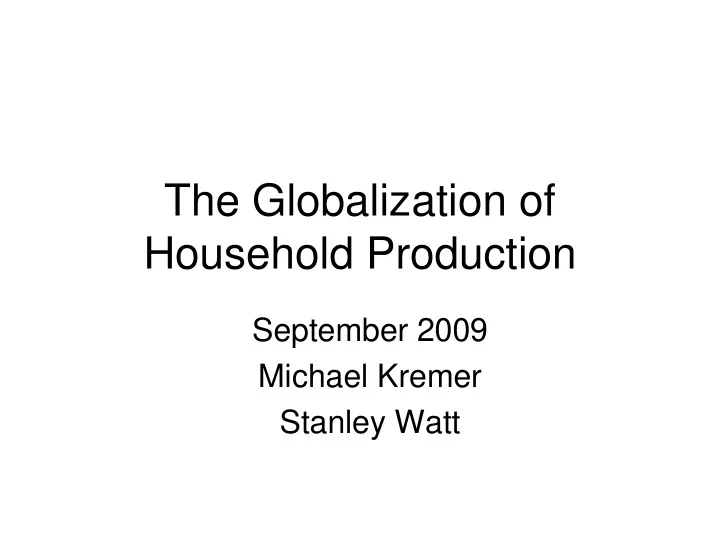

The Globalization of Household Production September 2009 Michael Kremer Stanley Watt
Obstacles to Migration • Migration restrictions arguably largest distortion in world economy, most costly for world’s poor • But many in rich countries see low- skilled migration… – changing culture/increasing crime – exacerbating income inequality among natives – creating fiscal drain on welfare state
Rise of FPHW Immigration • Women are increasingly crossing borders to work as foreign private household workers (FPHW) – “New Rich” countries – explicit programs, restricted visas (HK, Singapore, Taiwan, Gulf, Israel, Greece) – Within EU migration – UK, Ireland, Sweden now, others in 2011 – “Old Rich” - Limited enforcement of immigration restrictions against FPHW • Remittances increasingly important source of GDP – Sri Lanka 9%; Philippines 7%; Bangladesh 6.4%; El Salvador 17.6% • Less subject to three key obstacles
Model • Assumptions: – 2 sectors: A and C – Low, high skill labor – Cobb-Douglas production of A – 3 technologies for C – home, daycare, PHW • Limit on daycare consumption • Inefficiency or disutility of PHW • Result: FPHW immigration – Increases native low-skilled relative wages – Positive externality when taxes distort high-skill females incentives for market vs. home production • Robust to a small native PHW sector
How much female labor does a FPHW free up? • Israeli labor force participation data – Fixed effects: Self-reported hours worked last week increases by 5.4 hrs • Argentine household surveys – Fixed effects: Mothers’ hours work increases by 5.6 hrs • Cortes and Tessada (2007) - US time use data – Instrument for low-skilled migration with 1970 immigrant stock – Point estimate: each immigrant frees up 15.0% of a native worker • Ellwood, Wilde, Batchelder (2004) - panel data – 10 years after childbirth, women have 30% lower wages – Doesn’t include drop in hours or drop out of labor force
How much female labor does a FPHW free up? Table 4. Effect of domestic workers on mother's hours worked Estimation method OLS OLS FE FE (1) (2) (5) (6) Panel A. Argentina 15.656 8.332 5.62 5.636 Household has domestic worker [1.444]*** [1.441]*** [1.906]*** [1.923]*** 44246 44246 44246 44246 N Panel B. Israel 9.443 8.187 4.982 5.399 Household has domestic worker [1.220]*** [1.228]*** [1.228]*** [1.225]*** 34237 34237 34237 34237 N Y Y N N Cluster indicators N Y N Y Individual characteristics
Extensive Margin • Also, have results examining the extensive margin • Much larger effect for Argentina than Israel Table 5. Effect of domestic worker on mother's employment Estimation method OLS OLS Probit Probit FE FE (1) (2) (3) (4) (7) (8) Panel A. Argentina Household has domestic worker 0.315 0.119 0.326 0.183 0.118 0.122 [0.030]*** [0.030]*** [0.032]*** [0.048]*** [0.039]*** [0.039]*** N 44644 44644 44644 44636 44644 44644 Panel B. Israel 0.144 0.057 0.163 0.076 0.015 0.022 Household has domestic worker [0.023]*** [0.023]** [0.028]*** [0.034]** [0.016] [0.016] N 34257 34257 34246 34245 34257 34257 Cluster indicators Y Y Y Y N N Individual characteristics N Y N Y N Y
Welfare Impact • Externality welfare benefit of increased tax revenue: – Immigration * Displacement * High-skilled Wage * Marginal Cost of Funds * Marginal Tax Rate – 7% * 15% * 2 * 1.4 * 50% = 1.47% of wages (0.9% of GDP) • With 10% employer surplus, special tax levies - total welfare increase to 2.0% of wages (1.2% of GDP)
Wage Impact • Private Household Workers – High-skill labor % D = Immigration * Displacement / Fraction High-Skilled – 7% * 15% / 24% = 4.4% • With a Cobb-Douglas production function this is also a 4.4% increase in W L /W H • If CES w/elasticity of 1.5, wage ratio % D = 2.9%
Robustness of Calibration • What if day care centers were wholly staffed by low- skilled workers? – Low-skill labor % D = Immigration * Displacement * Daycare worker/PHW • 7% * 75.1% * 20% = 1.05% – Implies Cobb Douglas wage ratio % D = 4.4% - 1.4% =3.0%
Robustness of Calibration • Different parameter values • Leakage – Some FPHW enter general economy and compete with low-skilled natives – If 0.48 immigrants leak for every FPHW that remains in sector, h/1-h, wages unchanged, fiscal benefits – If 0.57 immigrants leak, low-skilled indifferent with fiscal benefits
Could “Old” Rich Adopt? • Ethical Paradox – Membership in society based on tenure • Ex ante – Welfare gains • Ex post – Ethical inconsistencies • Temporary Non-renewable Visas • Leakage – Enforcement issues
Limiting Leakage • Differential ability to control leakage in Singapore, Gulf, Europe, U.S. • Escrow portion of wages for use on return • Pritchett – sending country responsibility • Alternative: Licensing, bonding of employment agencies – create incentive for selection, incentive packages to encourage return • Ambrus – stay if upgrade skills
Impact? • Remittances – 7% of labor force are FPHW – Each FPHW remits $5,000 – 7% * 130 mil * $5,000 – Greater than $40 billion in remittances – 4X US official development aid • More new rich over time • Expansion of Europe? • Pressures to adopt: demography, glass ceilings for women • Addresses traditional obstacles to immigration, but raises new issues: ethics, limiting leakage
END
New Form of Immigration Foreign Domestic Helpers % Labor Force Country Year Kuwait 1995 19.9% Bahrain 2001 10.1% Saudi Arabia 2002 8.9% Singapore 2003 7.0% Hong Kong 2003 6.8% Greece 2001 1.0% Taiwan 2000 0.8% Israel 2001 0.8% USA 1998 0.3%
Avoiding Ethical Paradox • Avoiding abuse – right to change employer, keep visa • Temporary, non-renewable, visas – Extend Au Pair/Live in Caregiver programs – Politically attractive employers • Efficiency costs – human capital, moral hazard • More widespread benefits in sending country • Better for migrants? - behavioral economics, reference group issue • More remittances?
Recommend
More recommend